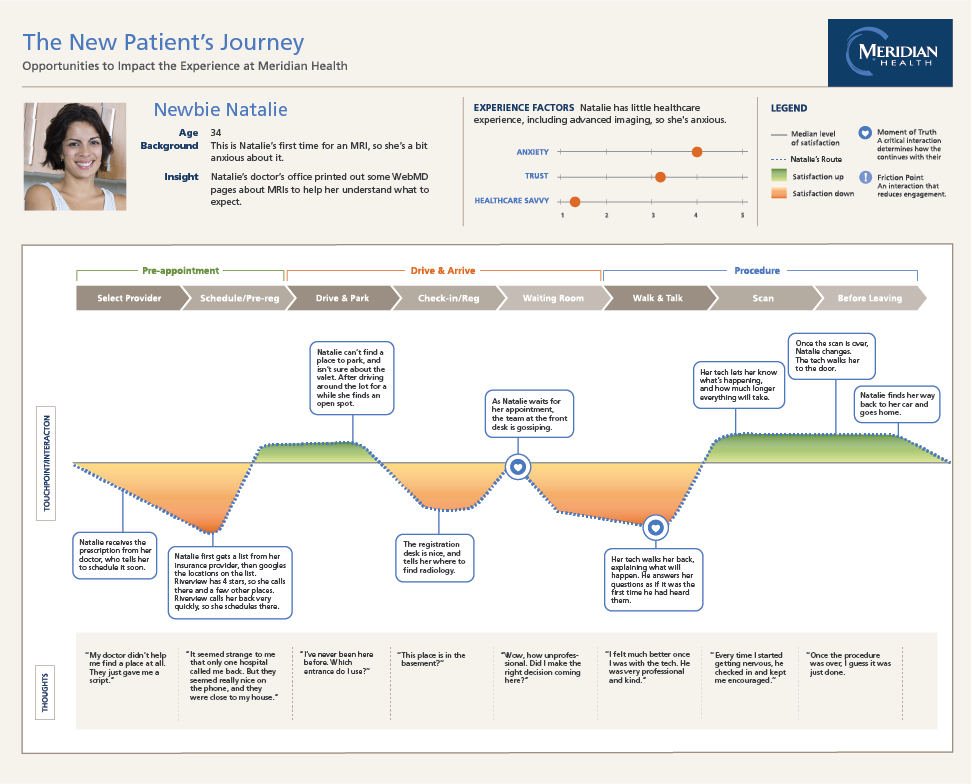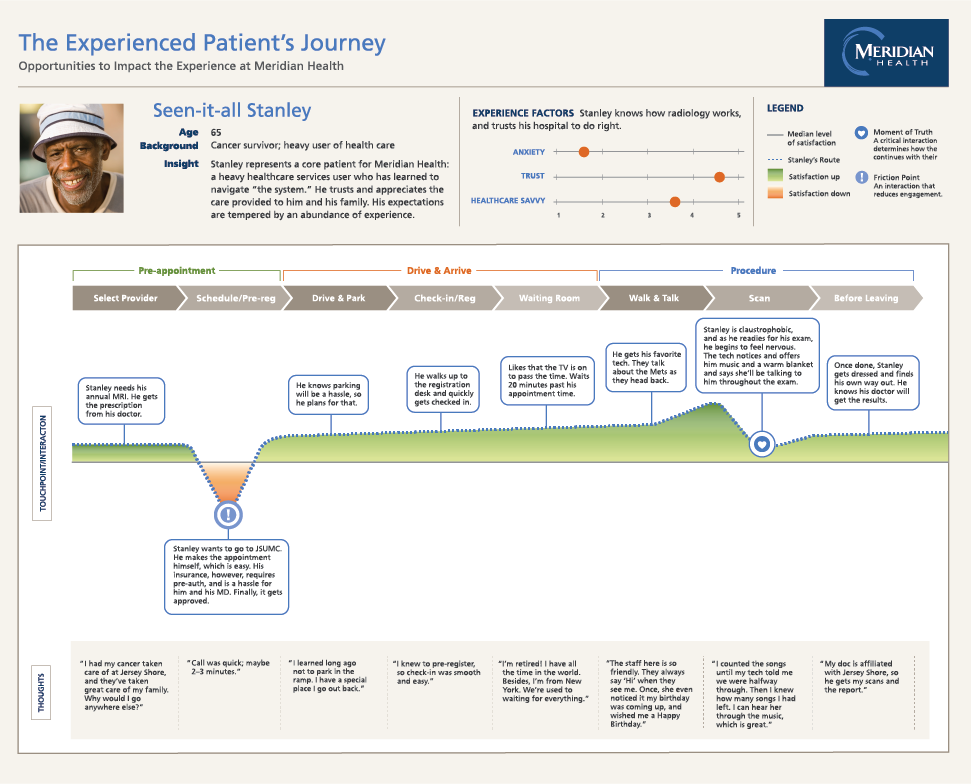
It’s hard to believe it’s been seven years since I launched my customer experience consultancy, Heart of the Customer, way back when CX was still in its infancy.
At that time, when I first wrote Customer Journey Maps – the Top 10 Requirements, I didn’t know the post would be viewed hundreds of thousands of times, and reposted around the world. But I did know that customer experience as a discipline – given its proven ability to boost customer loyalty and company results – was here to stay.
I enjoyed revisiting and updating the post back in 2015, but in the intervening years, the world has changed, the CX industry has evolved, research methodology has gotten more nimble, and technology has advanced. (And yet, somehow, none of us has aged a day – it’s uncanny!)
So it’s time once again to refresh the content. I am proud that the underlying philosophy and framework remains solid and consistent, but I’ve tweaked some terminology, techniques, guidelines, and examples.
In short, it’s an oldie, but a goodie, and I hope that regardless of whether you’re rereading it or encountering it for the first time, you will come away with something new and helpful.

Understanding your customer experience is the key to improving it…and to reaping the financial rewards that go hand in hand with increasing customer satisfaction and loyalty. And the best way to find out what customers do, think, and feel while interacting with your company is to create a customer journey map.
These visual representations show how a customer uses your product or service, or the decision-making process that turns a potential user into a customer. Undertaking the journey mapping process carries benefits that go way beyond the creation of a singular document, but here we will focus only on the maps themselves.
Guidelines are valuable because there is no “standard” map, since there is no “standard” customer experience. But not all journey maps are created equal. The best maps are highly customized, documenting your customer’s journey, as it is today, through your customer’s eyes. This allows you to easily identify where to focus your resources in the future, and the most cost-effective initiatives to implement to generate the greatest return on your investment (ROI) and the largest increase in customer loyalty.
The visual appeal of the document is extremely important, but the specific style is less so. You can build a map following high-quality design principles or use smiley faces. You can make it an engaging work of art or scribbles on a napkin. Ultimately, what is going to matter most is the content, and the integrity of the process used to compile it.
In this post, I’ll detail the criteria used to design and build the customer experiences and journey maps that can accelerate your customer experience program, focusing on the 10 critical components all great customer journey maps share. The examples we’ve peppered throughout the post show actual Heart of the Customer journey maps that incorporate these criteria.
Here’s what you need to include for an effective, actionable, customer-focused journey map:

A great customer journey map must represent the experience as your customer sees it, not the way you think they see it. That means it will often include aspects out of your direct control, such as social media influences, web searches, and steps your customers take before you even enter the picture.
For example, while studying the software purchase process for a large B2B client, Heart of the Customer – much to our client’s surprise – discovered that the vast majority of clients and prospects relied extensively on their own networks to create their list of vendors, ignoring conference trade shows, Google searches, and other more traditional forms of marketing.
While those channels were employed later in the purchase process, our discovery revealed that if the company didn’t win at “word of mouth,” they lost before they even knew they were in the running. This invaluable insight allowed the company to avoid wasting resources on programs that weren’t really impacting their results – or their bottom line – and instead concentrate on more effective relationship-building efforts.

You can’t rely on internal staff to build an accurate customer journey map. (Unless you employ a lot of mind-readers, in which case, go right ahead!) Depending on the scope of the customer journey map example, you’ll need interviews, ethnographies, surveys, and/or other types of customer research to figure out what’s really going on. Start with qualitative research, as your customer touchpoints often involve interactions and emotional responses that will be a surprise. We always begin there, then for some projects, follow up with quantitative surveys to confirm the results.
Talk to your customers. There is no substitute for having conversations with customers. Producing a map without talking to customers is what we call a hypothesis map. It is based on the hypotheses of the internal employees.
When I was at a large HSA company running the customer experience program, we led the nation in sales, but we also led the nation in churn. When I asked around, I found out that none of the people making decisions about the HSA product had ever talked to a customer to validate the customer’s journey. They said, “We are customers, so we do not have to talk with anyone else.” They were the strangest customers ever. They thought about HSAs all day, every day. No real customer experience matches that. When we talked to customers about their top pain points, we found the biggest driver of dissatisfaction was the inability to log in to the site. The internal group would never have considered this, as logging in was easy for them.
Some companies bring in customers to work hand in hand with employees to build the customer journey map, but care must be taken in that scenario to avoid the bias that results from a small or tainted sample. This approach typically works best with B2B companies that want to focus on a specific journey, such as customer support. In most cases, it’s best to do customer research first, then build on the information gathered.
The images show customer journey map examples



Different customers have very different customer journeys. For instance, while mapping how consumers purchase health insurance, we found that while one segment of customers spent only a couple of hours on research, another invested six weeks and used completely different tools. A great customer journey map doesn’t lump those two segments together because the result wouldn’t accurately reflect the experience of either.

When doing customer journey mapping for a large retailer, we found that customers were segmented by need rather than by demographics. The average customer, coming in on the way back from work to grab a few things for the evening had unique needs and a different customer experience than one who had a sick child at home and needed medicine late at night. Other customers came each week to hunt for deals for their necessities. Each customer needed different things from their customer journey. To design the future state, you must uncover the differences so you can design to meet the specific customer needs.

The solution is to identify the qualities and journey experiences of customers within a segment, and then use that data to build out a persona that represents that segment and brings their experiences to life. Naming the persona or personas allows employees to connect with their customer’s needs. Here are some examples of some personas, see if you can relate to any of them.
VP Vince — VP of Technology and Operations. He is tasked with implementing software that will transform the company’s business. He is focused on aggressive growth, modernization, automation, and innovation.
Cautious Carter — A buyer new to the Florida real estate market, relocating for a job and family. His goals are to find a realtor that is an expert in the Florida market to enable him to make a wise investment in the right property.
Security Driver Faye — A married woman in her 30s looking to purchase the right employee benefits. She wants to achieve peace of mind even if it costs a little more.
If you have already identified segments, use those in your research. If you haven’t, use your qualitative research to uncover different personas, which you can refine in the quantitative phase.

A great customer journey map illustrates what your customers are trying to accomplish at each stage of their experience and reflects whether those goals evolve as the journey progresses.
For example, when studying a healthcare journey for a hospital, we found that in the early stages, one persona focused extensively on understanding everything involved with the journey, whereas a different persona was just focused on getting through the process as quickly as possible. That revelation made designing cost-effective initiatives to meet the personas’ needs much easier.
The “jobs to be done” (JTBD) concept is a framework that helps businesses understand the underlying motivations and goals of customers when they “hire” a product or service to fulfill a specific job or task. It focuses on the progress a customer wants to achieve rather than the specific product or solution they are using. When applied to a customer journey map, the JTBD concept can provide valuable insights into understanding the customers’ goals at different stages of their journey.

It’s impossible to overstate the importance emotions play in any customer experience, whether B2B or B2C, because emotions are the key motivator behind every decision we make. Even when it comes to the largest organizations, ultimately, every decision is still made by a human being.
In his book, Thinking, Fast and Slow, Nobel Laureate Daniel Kahneman identified that the overwhelming majority of decisions are made automatically, based on an emotional reaction.
This includes customers’ decisions to renew or abandon their ScoreSense® subscription. Those with a positive emotional experience are typically more likely to renew — and pay for — programs than those with a neutral or negative experience.
Qualtrics’ XM Institute reports that when an emotional experience is positive, 90% of customers are promoters, whereas when it is negative or neutral, only 22% survey customers are.
More importantly, when problems occur, 74% of those with a positive emotional experience will forgive you, whereas only 19% of those with a negative or neutral experience will.
Great customer journey maps spotlight these emotions. I’m not a fan of using the smiley and frowning emojis prevalent in many existing customer journey maps, but the information does need to be conveyed somehow. Heart of the Customer always uses professional designers, but there are now so many graphic tools and options readily accessible to anyone with an internet connection that using smiley faces seems needlessly inadequate and, frankly, a little lazy.
In our work with a large SAAS software company, we noticed a set of eight emotions customers kept expressing about their experiences. These included emotions such as pride, confidence, frustration, and exhaustion. These were laid out on the customer’s experience journey map at the different phases.
We helped the company tie these emotions to some specific customer behaviors. Customers that expressed confidence were 50% more likely to purchase additional modules. For customers that expressed exhaustion during the later stages of implementation, the likelihood of purchasing went to almost zero.
This software company redesigned the future state so that when customers expressed confidence, a sales rep would reach out to see how best to get the next sale. When a customer expressed exhaustion, the company provided ‘free’ professional services resources to help reduce the exhaustion and in-service of the customer purchasing more in the future.
Take advantage of color, style, and graphic elements to put viewers of your map in the shoes of your customer and convey how customers feel throughout the journey.

One reason many clients choose to create a customer journey map is to better understand the order and type of each and every touchpoint – those times when your customer and your company interact – including those over which you have little direct control, such as the online research or referral from a friend that might lead a customer to your website early in their shopping journey.
“External” touchpoints are often some of the most important parts of the customer journey and are key to understanding the friction that occurs.
Advertising touchpoints: These include various channels such as TV commercials, radio ads, online banner ads, print ads, social media ads, and sponsored content.
Website touchpoints: Interactions that occur on the company’s website, such as landing pages, product pages, checkout process, customer support chat, and user account pages.
Social media touchpoints: Engagements that happen on social media platforms, such as Facebook posts, tweets, Instagram stories, YouTube videos, and customer comments or messages.
Physical store touchpoints: For businesses with physical locations, these touchpoints include in-store interactions, such as browsing products, talking to sales associates, making a purchase, or participating in events.
Customer service touchpoints: These touchpoints encompass interactions with the customer service team through support channels, including phone calls, live chat, email support, self-service portals, and support tickets.
Mobile app touchpoints: If the company has a mobile app, interactions within the app, such as signing up, navigating the app, making purchases, receiving push notifications, and using app-specific features.
Email touchpoints: Communication that occurs through email, including welcome emails, newsletters, transactional emails (order confirmations, shipping updates), and personalized offers.
Offline touchpoints: Any touchpoints that happen outside of digital channels, such as direct mail, brochures, catalogs, physical events or conferences, and product packaging. 60% of all customer touchpoints often occur in this group.
Word-of-mouth touchpoints: These include recommendations or referrals from friends, family, or colleagues, as well as online reviews and ratings on platforms like Yelp or Google.
Post-purchase touchpoints: Touchpoints occur after the customer purchases, such as post-purchase emails, product usage instructions, customer surveys, and loyalty programs.
Internal journey mapping done without capturing the voice of the customer is unlikely to take these customer steps into account – and therefore unlikely to be able to address and improve them – yet another reason involving real customers in your mapping efforts is so important.

Just as not all maps are created equal, not all interactions in the customer journey are equally important. Great journey maps reveal those Moments of Truth that have a disproportionate impact on a customer’s overall perception of the journey, and in doing so, pinpoint the key opportunities where your improvement efforts will provide the greatest return.
The outcome of these critical interactions might well determine whether a customer stops doing business with you or is so delighted they recommend you to their friends, family, and social media connections.
For one healthcare client, Heart of the Customer’s research revealed that problems during the hospital check-in process tainted the entire patient experience, even for patients that were otherwise quite satisfied with the care they subsequently received. In that circumstance, directly putting resources toward providing better care – a seemingly obvious way to improve customer satisfaction – would have little impact on loyalty. Removing the initial friction during the check-in process, however, increased customer loyalty and care ratings (for the same level of care) because it changed customers’ perception of the care received.
Here is a two-part Moment of Truth from a manufacturing company. First, the customer changes the delivery date or quantity, thinking, “Things have changed. I need to adjust the quantity.” The customer is feeling anxious. Second, the manufacturer changes the delivery date. The customer is now thinking, “Not again! Why does the manufacturer keep changing the date?” The customer is feeling powerless. One or both could happen.
We had measures to show the first scenario, where the customer changed the date, occurred 25% of the time. The second scenario, where the manufacturer changed the delivery date, occurred 20% of the time. Do you think we needed to improve the journey around those experiences? I’ll give you a hint…they were both far below the emotion line.
The moments resonated with employees, but the data created urgency.
For the first moment, we obviously needed to be nimble with the shifting customer needs. But for the second moment, we were REALLY negative impacting customer satisfaction with unreliable delivery. (By the way, showing up early with shipments is almost just as bad as showing up late.)

Done right, journey mapping can reveal how your brand promise aligns with the actual customer experience you’re providing, as well as how to fix issues if you’re falling short.
Do you sell your process as being effortless? Highly personalized? Affordable? A great customer journey map will show whether your customers believe you’re delivering – and if they think you’re not, how much their disappointment might be costing you in lost sales or increased expenses.

The length of a customer experience provides important context. Does a typical call last 30 seconds or 10 minutes? Did shoppers take an hour or a week to decide on a purchase? A great journey map recognizes that this information is essential and is built around it.
We mapped a journey for a financial services company. We mapped the onboarding journey for someone opening one of five different types of financial accounts.
The timing for each stage of the customer journey was important, like how the time between creating the account and signing the paperwork was negatively affected by the fact that 60% of customers needed to call customer service. The most crucial time was time to fund the account. If it took more than four days to fund the new account, the chance of funding went down by 75%. This outcome was bad for both the customer and the company.

The overarching themes of the story told by a journey map should be immediately obvious. But a great journey map is designed to be pored over and studied, with the nuances revealed in the details. Too many journey maps are created only for presentation on a screen, communicating basic information through concise bullet points. A great customer journey map defies those limitations.
Use a desktop publishing application and a professional designer to create your own customer journey map, so you can dive deeper and more freely and effectively convey the richness of the customer experience. These tools allow each customer journey map to be bespoke and not rely on a generalized customer journey map template.
The last few years have shown an explosion of software tools to help with customer journey map creation and customer journey management. Tools like Inspire Journey from Quadient and SuiteCX walk the line between being able to tell a story with powerful visualization and the need for advanced desktop publishing skills.
Each journey is unique and has its own touchpoints, phases, and Moments of Truth. When you start with a customer journey map template, you lock in your expectations and often will miss a touchpoint because it does not fit the template being used.
There you have it, as promised: 10 points that highlight the critical components of any great customer journey map. But we customer experience pros recognize the benefits of going above and beyond in our efforts to delight, right?
In longer journeys, customers are trying to accomplish different things, at different times, and in different ways. Document their mindset throughout, so you can tailor your customer experience to meet customer needs at every stage.
For example, it’s typical for preliminary steps in a shopping journey to revolve around finding out what questions to ask, but later steps in the journey are more transactional. Keep tabs on what your customer wants from you, and when they want it.
Including customer quotes – what they’re actually saying during and about the experience – isn’t strictly necessary, but I’ve found it really adds dimension to the experience and helps employees relate to what the customer is going through.
A pre-sales customer journey map should always include “the ones that got away,” i.e., the people who chose not to do business with you. Finding out where their experience differed from the people you successfully converted into customers is likely to shed a lot of light on the reasoning and emotions behind their decision-making process – and therefore illustrate where you should target your interventions.
For example, one Heart of the Customer journey map revealed that our client’s “non-customers” were typically people who relied on in-person meetings when making purchasing decisions – something our client didn’t offer at the time. That realization was critical to their improvement efforts, and yielded corresponding financial benefits.
Journey maps shouldn’t stand alone. Just as your maps can explain the findings from other methods of customer feedback, other methods of research can add richness to your journey maps.
Factor in operational data, such as the length of the journey, error rates, or the number of support calls, to add explanatory power and context to your journey maps, especially when presenting to executives.
Keeping these 10 (plus four) components in mind during your customer journey mapping process will ensure you create a rich document that provides a solid foundation for your customer experience efforts. But make sure they don’t just gather dust on a shelf! Use what you’ve learned to drive action, manage your journey, and improve your business outcomes.
Our blog offers many more examples of how we apply these principles to benefit our clients. For additional details about our proprietary journey mapping process, download our journey mapping toolkit, watch our webinars, and peruse our authoritative journey mapping guidebook, How Hard Is It to Be Your Customer?
You might also find our recent white papers of interest:
CX for Skeptics: Showing the ROI of CX
Driving Change Through Journey Maps
At Heart of the Customer, we understand that the key to an exceptional Customer Experience (CX) is understanding the customer’s journey. In this FAQ, we’ll dive into the essentials of customer journey mapping to help you improve your CX strategy.
A customer journey map is a visual representation of the entire experience a customer has with your company, from initial contact to long-term engagement. It’s designed to showcase the customer’s interactions, emotions, expectations, and pain points at each stage of their journey. By creating a customer journey map, you gain valuable insights into customer needs and preferences, helping you tailor your products, services, and communication to create the best possible CX.
The primary goal of a customer journey map is to understand the customer’s perspective better, allowing you to improve the overall CX. It can help you identify areas of friction or dissatisfaction, discover opportunities for innovation, and streamline your processes. Ultimately, an effective customer journey map enables your organization to make more informed decisions, enhance customer satisfaction, and drive business growth.
Customer journey maps can vary in format and complexity, but they generally include these key components:
There are several methods for creating a customer journey map, but these three techniques are particularly popular:
– Workshop-based mapping: Involves collaborative brainstorming sessions with cross-functional teams, ensuring a comprehensive understanding of the entire customer journey from multiple perspectives.
– Data-driven mapping of the buyer journey: Leverages quantitative and qualitative data (e.g., surveys, analytics, customer feedback) to build an evidence-based map of the customer’s journey.
– Diary study mapping: Customers record their experiences with your company over a certain period, providing first-hand insights into their emotions, thoughts, and behaviors.
By understanding the fundamentals of customer journey mapping, you’re better equipped to unlock the full potential of your CX strategy. Remember, a well-crafted customer journey map can illuminate opportunities for improvement and help drive your organization’s success. Happy mapping!

